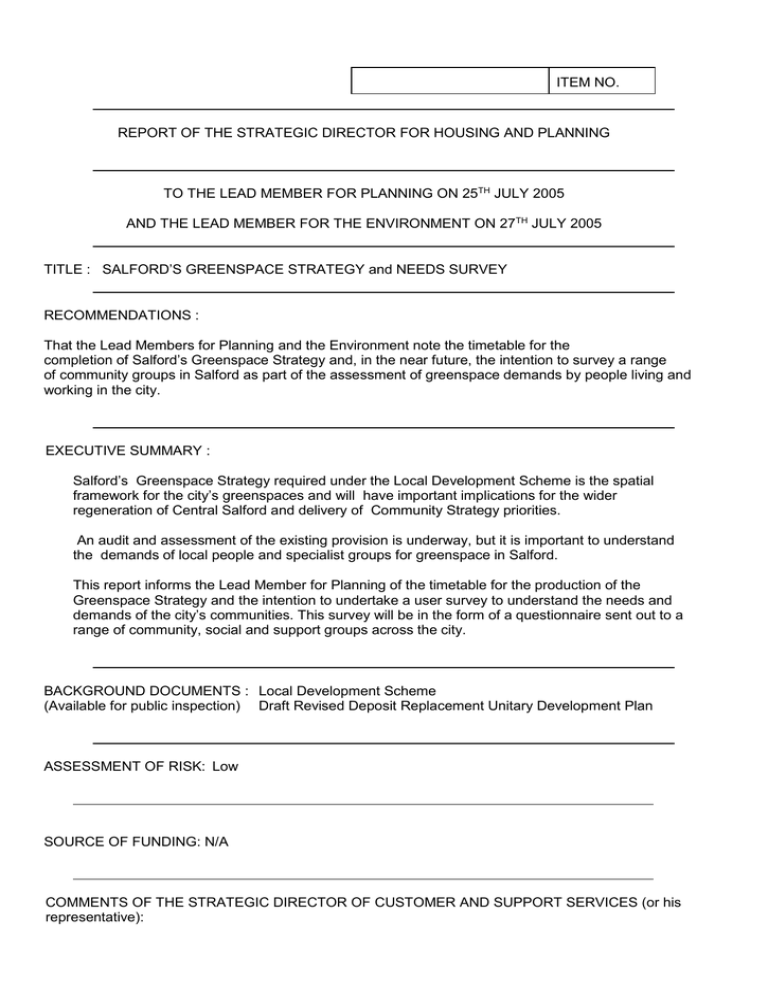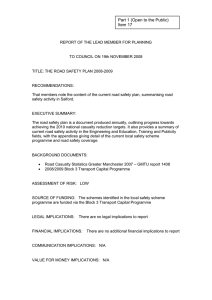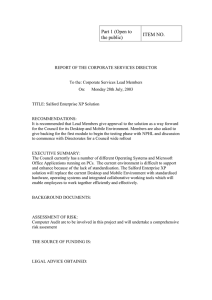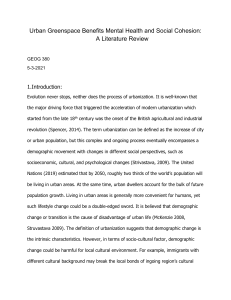ITEM NO. REPORT OF THE STRATEGIC DIRECTOR FOR HOUSING AND PLANNING
advertisement

ITEM NO. REPORT OF THE STRATEGIC DIRECTOR FOR HOUSING AND PLANNING TO THE LEAD MEMBER FOR PLANNING ON 25TH JULY 2005 AND THE LEAD MEMBER FOR THE ENVIRONMENT ON 27TH JULY 2005 TITLE : SALFORD’S GREENSPACE STRATEGY and NEEDS SURVEY RECOMMENDATIONS : That the Lead Members for Planning and the Environment note the timetable for the completion of Salford’s Greenspace Strategy and, in the near future, the intention to survey a range of community groups in Salford as part of the assessment of greenspace demands by people living and working in the city. EXECUTIVE SUMMARY : Salford’s Greenspace Strategy required under the Local Development Scheme is the spatial framework for the city’s greenspaces and will have important implications for the wider regeneration of Central Salford and delivery of Community Strategy priorities. An audit and assessment of the existing provision is underway, but it is important to understand the demands of local people and specialist groups for greenspace in Salford. This report informs the Lead Member for Planning of the timetable for the production of the Greenspace Strategy and the intention to undertake a user survey to understand the needs and demands of the city’s communities. This survey will be in the form of a questionnaire sent out to a range of community, social and support groups across the city. BACKGROUND DOCUMENTS : Local Development Scheme (Available for public inspection) Draft Revised Deposit Replacement Unitary Development Plan ASSESSMENT OF RISK: Low SOURCE OF FUNDING: N/A COMMENTS OF THE STRATEGIC DIRECTOR OF CUSTOMER AND SUPPORT SERVICES (or his representative): 1. LEGAL IMPLICATIONS N/A 2. FINANCIAL IMPLICATIONS. The costs associated with the Needs Survey will be met through existing budgets. Other costs during the production of the strategy, including the document and public consultation will be met through the UDP Budget or Planning Delivery Grant. PROPERTY (if applicable): N/A HUMAN RESOURCES (if applicable): The work will be undertaken by existing staff in Development Planning with additional support from Environmental Services. CONTACT OFFICER : Elizabeth Dixon Ext. 3659 WARD(S) TO WHICH REPORT RELATE(S): KEY COUNCIL POLICIES: DETAILS (Continued Overleaf) All Review Unitary Development Plan Community Plan : Enhancing Life in Salford ( Pledge 7) Salford’s Greenspace Strategy 1.0 Purpose of the Report 1.1 The purpose of the report is to inform Lead Member about the key steps and timetable for producing Salford’s Greenspace Strategy, and in the short term, the intention to survey a range of community groups to gather information about local demands for greenspace by people living and working in the city. 2.0 Background 2.1 Good quality, accessible green space and natural areas enhance the quality of life of local people and create a confident attractive city environment. 2.2 The Salford Greenspace Strategy will be a Supplementary Planning Document (SPD) forming part of the Local Development Framework. The Strategy will give detailed guidance on the implementation of recreation policies in the Review Unitary Development Plan. It will ensure that Salford is in compliance with national planning guidance provided by PPG17. 2.3 Lead Member will be aware that a substantial amount of work and consultation was undertaken last year to produce the Draft Urban Open Space Strategy ( UOSS). This deals with formal outdoor recreation facilities (play areas, parks and playing fields) and the setting of local standards for its future provision. 2.4 Sites in the UOSS comprise only 30% of Salford’s Greenspace and both during consultation for the UOSS and during the UDP Inquiry considerable interest was expressed in the protection and role of the wider greenspaces in Salford 2.5 The Local Development Scheme is timely in this respect and confirms Salford’s commitment to producing a Strategy for all greenspaces across the city, including the sites contained in the Draft Urban Open Space Strategy. 3.0 Context 3.1 There is an increasing emphasis in the council’s strategic regeneration and corporate policy commitments on the provision of high quality greenspaces. - Central Salford Vision recognises the special part that greenspaces can play in complementing the River Irwell and outstanding architecture. - Housing Market Renewal which increasingly recognises that importance of high quality parks and green spaces providing high quality settings and connections between neighbourhoods. - A Regional Park which could provide a facility of linked greenspaces the length of the Irwell Valley connecting people and places and delivering a wide range of recreation, sporting and visitor attractions. - Sustainable Development , and addressing the council’s response to Climate Change will demand a central role for greenspaces, as green lungs for the city, tackling air pollution, providing urban drainage and reservoirs for urban wildlife. - Salford’s Draft Community Plan recognises greenspaces (and its waterways) as one of Salford ‘s key assets. One of the challenges for the LSP will be to ensure that the role of greenspaces is recognised as a cross cutting theme helping to deliver health benefits, opportunities for young people, community benefits, economic prosperity as well as a high quality living environment. 3.2 The spatial commitment to greenspace is provided by the Draft Unitary Development Plan with a range of Recreation Policies that protect it ( R1), establish standards of provision ( R2), support the concept of the Regional Park ( R3), establish Key Recreation Areas ( R4), promote a network of strategic connections ( R5) and allocate sites for improvements( R6). The Salford Greenspace Strategy will provide guidance to help to deliver these policies. 4.0 Salford’s Greenspace Strategy 4.1 The Greenspace Strategy will audit and assess all the greenspaces that fall within the definitions provided by PPS17. These will be identified regardless of ownership or existing public access provision and will cover a wide variety of functions and characteristics, including : Country Parks Local Nature Reserves Woodlands Rivers/Canals Lakes/Reservoirs/Ponds Looplines (created along the dismantled railway lines) Golf courses Cemeteries Allotments Informal/natural green space areas within the built environment Playing fields Formal play and recreation facilities Informal play areas 4.2 The Greenspace Strategy will contain specific guidance in relation to the resource to be protected, the standards for future provision and recommendations for how these standards will be met. Areas of deficiency will be identified, along with strategic connections between important areas of green space and urban neighbourhoods. It will contain guidance about the circumstances under which replacement provision will be required, when a site might be declared surplus and the form of compensation that might be required 4.3 The Strategy will help to inform regeneration proposals across the whole city through identifying what greenspaces we have, what they are used for, what the community demands are, where improvements should be prioritised and what, if any might be considered surplus to future requirements. 4.4 It is expected that the Strategy will be of particular value to colleagues in Environmental Services by helping to identify priorities for improvements and provide the basis for bids for resources. 5.0 Work Programme 5.1 A broad outline of the timetable for the key stages of work is outlined below : Audit of existing wider greenspace sites ( excluding work already completed for UOSS) May – August 2005 Needs Survey July – September 2005 Analysis of Data/Setting Standards July – October 2005 Sustainability Appraisal July 2005 – February 2006 Stakeholder Group / Consultation Workshop October 2005 Preparation of Strategy / Planning Guidance October 2005 – January 2006 Formal consultation period for the Supplementary Planning Document for the Greenspace Strategy: February - March 2006 Expected date for Adoption: August 2006. 6.0 Proposed Needs Survey 6.1 The audit and assessment of the categories of greenspace is well under way in order to provide firm evidence of what already exists. 6.2 An important part of the evidence base is to understand the needs of the city’s communities. The survey work will be carried out over July – September 2005. 6.3 A questionnaire and covering letter has been prepared to send to a range of community, social and interest groups across the city ( Appendix A). 6.4 Experience in Trafford with a similar piece of work suggested that there was a much greater benefit in approaching a wide range of established residents and community groups rather than a random postal or newspaper questionnaire. A large number of groups have been identified from Community Committee databases , many of which are not specifically associated with greenspaces. It is hoped that the broad community interest in greenspaces and local places will provide a high response rate and good representation of the city’s population. 6.5 Lead Member is asked to note the content of the survey and that questionnaires will be sent out over the summer period. Malcolm Sykes Strategic Director of Housing and Planning APPENDIX A: COVER LETTER AND QUESTIONNAIRE Development Planning Housing and Planning Salford Civic Centre, Chorley Road Swinton, Salford M27 5BW Phone Fax Email Web 0161 793 3659 0161 793 3797 elizabeth.dixon@salford.gov.uk www.salford.gov.uk My Ref Your Ref Date: 22 July 2005 Subject: WIDER GREENSPACES STRATEGY SURVEY Dear Sir/Madam Salford City Council recognises the importance of open space to the quality of life of local people. Officers from Development Planning are preparing a strategy for the city covering all green space areas. Urban Open Spaces were examined last year, setting standards for outdoor play areas, parks and sports facilities. It was subject to major consultation and this work will be integrated into the Greenspace Strategy. The purpose of this survey and the reason for seeking your help is therefore to look at the wider greenspaces in the city (ie not play areas, party and sports pitches). These wider green space sites will be considered regardless of ownership or level of public access and will cover a wide variety of functions and characteristics. The type of sites which will be covered in the Strategy will include: Country Parks & Local Nature Reserves Woodlands Rivers/Canals & Lakes/Reservoirs/Ponds Looplines (created along the dismantled railway lines) Golf courses Cemeteries Allotments Informal/natural green space areas within the built environment The Strategy will, among other things, set local standards for the provision of green space in the city; highlight deficiency areas within the city; identify key sites for provision and improvements to informal recreation; and recommend where access improvements should be carried out to, and between, open space sites. At this stage we are carrying out an audit and assessment of the existing provision and demand for the wider greenspaces in Salford. Part of this is a user survey to understand what sites are particularly valued , whether there is enough greenspace in the right places and how it should be managed. A questionnaire is being sent out to a range of community, social and support groups across the city. The groups chosen may not necessarily be traditionally associated with greenspaces. However, it is hoped that this approach will provide wide representation of all of the city’s population. We consider it is important to find out who is and who is not using the city’s greenspaces and why. We are contacting you as a senior member of a group contributing to Salford’s community, and would be very grateful if you could complete the enclosed Questionnaire. The questionnaire should be completed either: 1) As a group; 2) As individuals (feel free to copy the questionnaire and complete); or 3) By yourself, if you feel you are able to answer on behalf of your group. If you or your group uses a particular greenspace site for its activities , please include reference to this in the questionnaire (questions 1 and/or 2). Even if your group never uses wider greenspaces in the borough, I hope you will be able to take part in this survey. The questionnaire is also available for completion and submission on-line at www.salford.gov.uk . Please return completed questionnaires to the above address marked ‘Wider Greenspace Strategy’ and for the attention of Frances Taylor by 2 September 2005. Thank you very much for your anticipated help. If you require any further information, please contact me on 0161 793 3659. Yours Faithfully, Elizabeth Dixon PLANNING OFFICER (ENVIRONMENT AND PROJECTS GROUP) Salford’s Wider Greenspaces Strategy Questionnaire Name: Organisation: Address: Telephone Number: Email: How old are you? Under 11 years 20 – 35 years 11 – 16 years 35 – 65 years 16 – 20 years Over 65 years How many Children do you have in the following age ranges (if applicable)? 0-4 years 9-14 years 4-8 years 15-18 years Question 1: Do you value the greenspaces in your area ? ( please provide some details) Question 2: What is the name / location of the informal/natural green space site you visit most regularly? Question 3: Are there enough informal/natural sites in your area? Yes No Don’t know Question 4: How often do you visit informal/natural sites in Salford? Every day Once every six months Once or twice a week Once a year Once a month Less often Question 5: How do you get to the informal/natural site/s? Walk Bus Bicycle Car Motorbike Other (please specify) Question 6: What time of day do you normally visit the informal/natural site/s? No particular time 1:00pm to dusk Before 9:00 am After dusk 9:00 am to 1:00 pm Question 7: What is the main purpose of your visit to the informal/natural green space site/s? Play with friends Fishing For a family outing Experience nature/observe wildlife Walk the dog To take a short cut Walking To relax/contemplate Jogging For educational reasons Cycling Other (please specify) Question 8: What is the normal length of your stay at the informal/natural site/s? < 30 minutes 2 – 4 hours 30 mins to 1 hour 4 hours 1 – 2 hours Question 9: Why do you visit the particular informal/natural site/s above? Facilities available (please state facility type) Easy access Quality of site Close proximity to home/school/work Other (please specify) Question 10: Are there any reasons why you don’t visit informal/natural areas in Salford? Fear of crime / anti social behaviour Lack of sites available close to home Poor access Lack of knowledge of sites within your neighbourhood/Salford Vandalism Lack of Facilities Other (please specify) Prevention of access for wheelchair/pushchair Question 11: What do you think would be the single best way to improve the informal/natural green spaces in Salford? Increase quantity Provide specific facility within the site (please specify) Improve quality Improve access to the sites Improve accessibility within the sites Provide greater variety of habitats for wildlife Other (please specify) Please feel free to use the space below to provide any additional comments you have to do with Salford’s wider green spaces. Thank you very much for your help.


